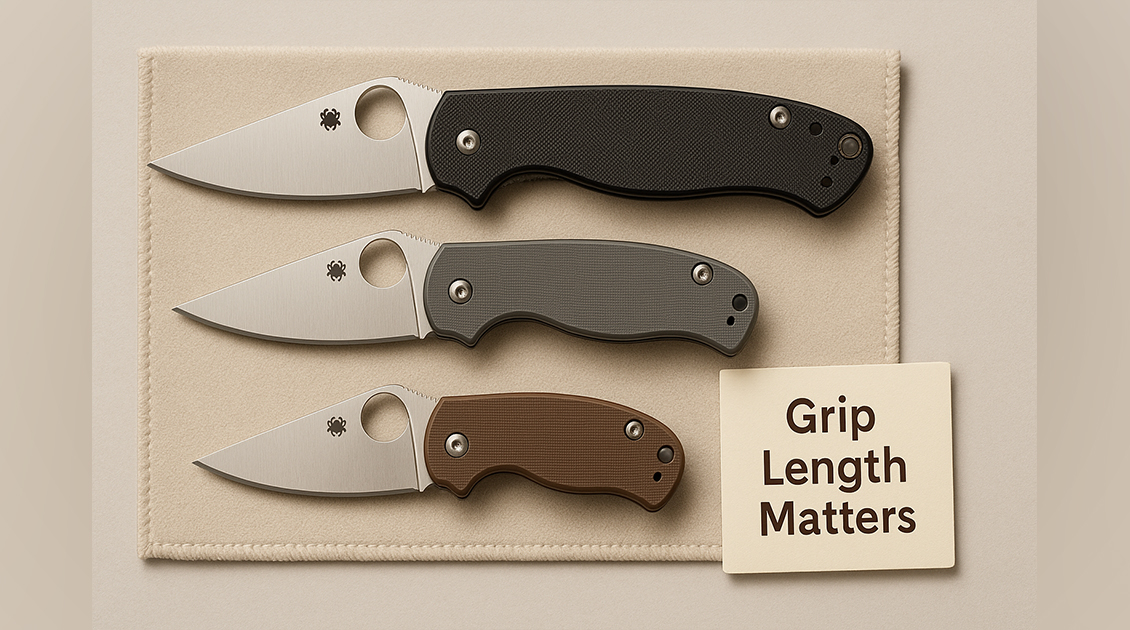Should You Shorten or Extend Your Spyderco Handle? Key Considerations

This is the 44th blog of the Spyderco blog series. You can check the other blogs I wrote from here – https://spydercoparts.com/blogs
Author: Logan M. Fraser
Occupation: Custom Knife Modder & Spyderco Parts Specialist
Location: Calgary, Alberta, Canada
When it comes to Spyderco handle modifications, one of the most debated topics is whether you should shorten or extend the handle. Knife enthusiasts often want to improve comfort, control, or aesthetics—but altering a handle isn’t a decision to take lightly. Over the years, I’ve modded plenty of Spydercos, from trimming down bulky grips to extending compact models for more secure use. Each path has its advantages and trade-offs, and in this blog, I’ll break them down for you.
Why Handle Length Matters 
The handle of a folding knife is more than just something to hold onto. It determines:
-
Ergonomics: How the knife feels in hand during extended use.
-
Leverage & Control: A longer handle can provide more control for tough cuts.
-
Portability: A shorter handle makes for easier carry.
-
Balance: Handle length affects how the blade feels in motion.
Spyderco designs their knives with specific ergonomics in mind, but sometimes factory setups don’t match personal preferences—especially if you have larger or smaller hands than average.
When to Shorten Your Spyderco Handle 
Shortening a handle is usually about portability and aesthetics. Here’s when it makes sense:
-
EDC Slimming: If you carry your Spyderco daily and want less bulk in the pocket.
-
Sheeple-Friendly Mod: A smaller profile looks less intimidating in public use.
-
Custom Grip Preference: Removing excess material can help eliminate “hot spots” during cutting.
Drawbacks: Shortening can compromise leverage, making hard-use tasks trickier. It may also affect resale value, since factory originality is often prized among collectors.
Pro Tip: If you’re planning to shorten, do it gradually. Remove small amounts of material, test in-hand, and repeat. It’s far easier than trying to fix an over-cut handle.
When to Extend Your Spyderco Handle 
Extending is less common, but I’ve done it for clients who wanted a more substantial grip. It’s useful when:
-
Large Hands: The factory handle feels cramped and leaves pinky unsupported.
-
Outdoor / Heavy Use: A longer handle offers more leverage for bushcraft, food prep, or rope cutting.
-
Aesthetic Builds: Some modders love the look of a stretched profile with custom scales.
Drawbacks: Extending increases weight and may affect balance. It can also make the knife harder to pocket-carry discreetly.
Tools & Materials You’ll Need 
For either shortening or extending, you’ll need:
-
Torx drivers (T6, T8, T10 for Spyderco screws)
-
Replacement scales (available here)
-
Epoxy or scale material (micarta, G10, titanium, etc.)
-
Sanding / grinding tools (Dremel, files, wet sandpaper)
-
Finishing oil or sealant for natural materials
Having quality aftermarket parts makes the job easier. Precision-fit scales and lanyard tubes from SpydercoParts.com ensure you’re not dealing with poor tolerances.
Step-by-Step: Shortening a Spyderco Handle 
-
Disassemble the knife carefully with Torx drivers.
-
Mark the cut on the handle scales using masking tape and pencil.
-
Sand or grind slowly, testing fit in your hand after each pass.
-
Re-chamfer the edges to maintain comfort.
-
Reassemble and check blade clearance, centering, and action.
Step-by-Step: Extending a Spyderco Handle 
-
Choose your material (micarta, titanium, G10) to match or contrast factory scales.
-
Fabricate an extension that bonds seamlessly with existing scales.
-
Epoxy and clamp the extension firmly, letting it cure fully.
-
Shape and contour the extension to maintain ergonomic flow.
-
Reassemble with new screws or standoffs if needed.
Functional vs. Aesthetic Mods 
A big part of the decision comes down to whether you’re chasing utility or style. A shortened Delica might be the perfect discreet EDC, while an extended PM2 could become your camp workhorse. Neither option is “wrong”—it depends on what you value more: portability or control.
Product Tie-In: Parts That Make Mods Easier 
If you’re diving into handle mods, here are parts I recommend:
-
Spyderco Replacement Scales: Precision-machined for direct fit, available in micarta, G10, and titanium.
-
Lanyard Tubes & Standoffs: Essential when reassembling after cutting or extending.
-
Custom Backspacers: Great for balancing aesthetics after modifying handles.

Real-World Experience 
I’ve modded knives for folks who regretted cutting too much, and others who couldn’t be happier with a slimmer EDC. One memorable project was extending a Para 3 handle for a client with XXL hands—it completely transformed how usable the knife felt for him. These experiences taught me the importance of planning ahead and knowing your goal before touching the Dremel.
Sources & Further Reading 
-
Spyderco Forums discussion on ergonomics: https://forum.spyderco.com
-
Knife pivot maintenance guide: https://knifepivotlube.com
These resources provide community insights and technical know-how to back up the practical advice here.
Wrapping It Up
So, should you shorten or extend your Spyderco handle? It depends on your priorities. If portability and low profile matter, shortening is the way. If you want more control and a fuller grip, extending could be worth it. Either way, the key is intentional modding—know your purpose, use the right parts, and take your time.
This blog is part of my ongoing Spyderco series, where I share hands-on modding experience and practical upgrades. You can browse the rest of the series here: https://spydercoparts.com/blogs
Got a question about handle mods? Drop it in the comments—I’ll answer personally. And tell me what you’d like to see next week: sharpening tips, lockbar tweaks, or full-scale regrinds? Let me know.


